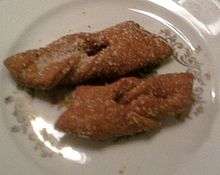Cruller
A cruller (/ˈkrʌlər/) is a deep-fried pastry popular in the US and Canada often made from a rectangle of dough, with a cut made in the middle that allows it to be pulled over and through itself producing twists in the sides of the pastry. Crullers have been described as resembling "a small, braided torpedo".[1] Some other cruller styles are made of a denser dough somewhat like that of a cake doughnut formed in a small loaf or stick shape, but not always twisted.[2] Crullers may be topped with plain powdered sugar; powdered sugar mixed with cinnamon; or icing.
 Cinnamon glazed cruller | |
| Alternative names | Twister |
|---|---|
| Type | Pastry/Doughnut |
| Variations | French cruller |
A French cruller is a fluted, ring-shaped doughnut made from choux pastry with a light airy texture.[3] The German spritzkuchen is very similar.
History

The name comes from early 19th century Dutch kruller, from krullen 'to curl'. In northern Germany they are known as hirschhörner (deer horns). They are traditionally baked on New Year's Eve as a family project with the kids doing the labor-intensive shaping and the grown ups handling the deep frying. In Danish they are known as klejner and in Swedish as klenäter, both names deriving from Low German. In Scandinavia crullers are common at Christmas. In the US various shapes of pastries are known as crullers. Some forms of those crullers are what is traditionally eaten in Germany and some other European countries on Shrove Tuesday, to use up fat before Lent.
The term "Chinese cruller" is occasionally applied to the youtiao (Chinese: 油条), a similar-looking fried dough food eaten in East and Southeast Asia.[2][4] The term cruller is also associated with the mahua (Chinese: 麻花).[5] Mahua is a type of twisted fried dough much denser and sweeter than youtiao.
The "Aberdeen crulla" is a traditional Scottish pastry made in the same way as the rectangular, plaited cruller of New England.[6] It is first attested in Edinburgh in 1829 and is thought to copied from the 'cruller' of the United States according to the Scottish National Dictionary (1931–1976).[7] Distinct from this, the "yum-yum" is a commonly available treat in Scotland, which resembles a straightened French cruller coated in thin glacé icing.
In 1909 a US author published her belief that crullers were invented in the New World in 1617 by Sebastian Croll, due to the perceived similarity of the names according to her.[8]
Dorothy in The Wizard of Oz sings "Over the Rainbow" early in the movie holding what's left of a cruller Aunt Em had offered to her after giving them to Hunk, Hickory, and Zeke, her "three shiftless farmhands". The twisted shape of the cruller might have been a metaphor for tornadoes as the same scene references other metaphors which influenced Dorothy's subsequent dream.
Availability

Crullers are most commonly found in Canada, New England, the Mid-Atlantic and North Central states of the United States, but are also common in California. The German origin is probably why traditional crullers can be found more easily in the Midwest, where many German immigrants settled. Some family-owned bakeries still call them "krullers."
In 2003, the Dunkin' Donuts chain of doughnut shops stopped carrying traditional crullers, claiming that the hand-shaped rectangular treats were too labor-intensive, and couldn't be simulated with new machines for mixing doughnut batter. The company still sells "French crullers"[1] which can be formed by a kind of extruding nozzle.[9]
Tim Hortons,[10] and Honey Dew Donuts[11] still sell the Cruller doughnut. Krispy Kreme[12] sell a similar doughnut the company refers to as a cruller, but in reality it is just a molded/formed cake (or Old Fashioned) doughnut. In place of the traditional cruller, Dunkin' Donuts now sells several variations of a substitute product it calls a "cake stick" which is a simplified, machine-made rectangular version of the elaborately twisted, hand-made variety.[13] In the southeastern U.S., French crullers are a fresh-baked everyday bakery item at Publix grocery stores.
In 1973, the French cruller became available in Mister Donut stores in Japan.[14]
See also
- List of doughnut varieties
- Berliner (pastry), another doughnut popular in Germany
- Fasnacht (pastry), another Shrove Tuesday related doughnut
- Koeksister, a twisted doughnut popular in South Africa
- Long John (doughnut), the common American rectangular doughnut, made from a yeast dough
- Maejap-gwa, a ribbon-shaped Korean pastry
- Oliebol, the basic Dutch doughnut
- Twisted doughnut
References
- Joseph P. Kahn, "With Progress, a Cruel Twist", Boston Globe, 25 October 2003.
- John Foust. "Midwestern Crullers". www.gojefferson.com. Retrieved 24 June 2017.
- Smith, Patti (2010). Just Kids. New York, New York: Ecco. p. 111. ISBN 978-0-06-621131-2.
- Rhonda Parkinson (3 May 2017). "If You Want a New Breakfast Idea, Then Go Chinese!". The Spruce. Retrieved 24 June 2017.
- "crullers". Youdao dictionary. Accessed August 1, 2013.
- F. Marian McNiell, "The Scots Kitchen",
- "Crulla n.". Dictionary of the Scots Language – Dictionar o the Scots Leid. Scottish Language Dictionaries Ltd. 2004. Retrieved 15 November 2018.
- Bradbury, Mrs. Anna R. (1909). "The Dutch Occupation". History of the city of Hudson, New York : with biographical sketches of Henry Hudson and Robert Fulton. Hudson, N.Y.: Record Print. and Pub. Co. p. 7.
... Sebastian Croll (pronounced Crull) was placed in command. He is the traditional inventor of the cruller ...
- US patent 3396677, Adams Floyd N, Cooper Victor D, Sommers John E, "Shaped doughnut cutting device", published Aug 13, 1968, assigned to Dca Food Ind
- Tim Hortons Snacks & Baked Goods
- "French Cruller | Honey Dew Donuts". www.honeydewdonuts.com.
- "Glazed Cruller". krispykreme.com. Retrieved 19 June 2015.
- "Dunkin' Donuts Product List". Archived from the original on 1 February 2012.
- "History of Mister Donut" (in Japanese). misterdonut.jp. Retrieved 12 February 2016.
External links
